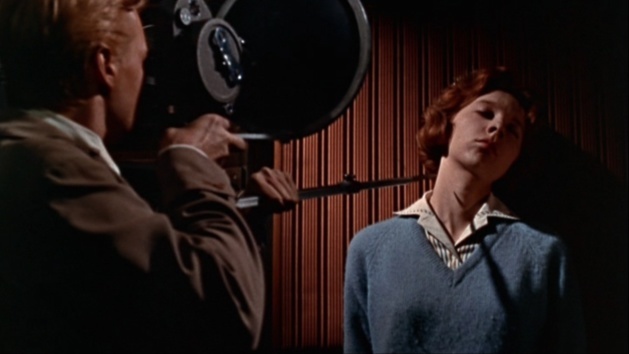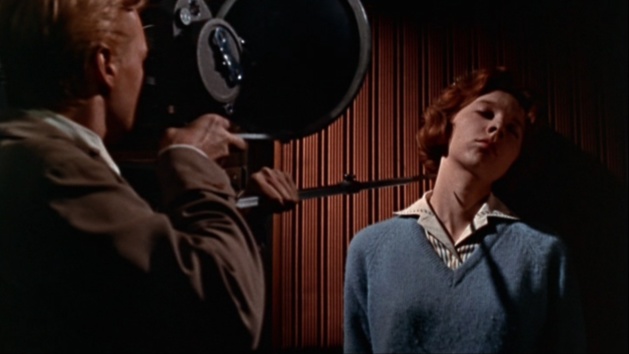
“This movie is an offence to the nation”,“it is a disgusting movie”, “harmful and damaging”. The British response was cutting when the film was released in 1960. It was only in 1979, when Martin Scorsese bought the rights, that Peeping Tom was revived as a cult movie, investigating the link between the image and the spectator. Michael Powell gives a wounding portrait of British society through Scopophilia, the pleasure of watching murder scenes. The genius of Powell is in the murder weapon : it is incorporated at the bottom of Lewis’ video camera. Usually thoughtful and attentive, he does not consider his victims as victims: they are only the object of his work.
A mise en abyme : When the Spectator becomes Voyeur
Powell uses the subjective camera to put the spectator at the centre of the murders committed by Lewis, a deadly camera. Then comes the feeling of immediate awkwardness, because we have to follow and embody the author through his repulsive and disgusting action against our will, without being able to step back like when an objective camera is used. This mise en abyme of the principal framework of the movie is a declaration of love for film.
Through the use of this means of shooting, Powell gives us an exhaustive vision of film, from the very first two sequences of the movie, in other words the first murder and the projection of the murder video. In those two scenes successively interlocked, firstly we adopt Lewis’ point of view, shooting and murdering a woman, then the victim’s point of view and finally one of an external spectator watching the video of the murder. In this way, the spectator is cameraman, actor and spectator, successively… He has experienced all three fundamental positions on which film is constructed.
Powell’s Apex
Despite all this, Lewis is an endearing character, discreet and shy with his charming neighbour Helen, who has an effect on him. But when the camera is on, he becomes a vicious psychopath methodically and meticulously preparing the staging of his murders. He enjoys every moment preceding the murder with a macabre fascination. Killing is not important to him, only the images matter. The murder scenes are suggested, but never revealed to the spectator.
Peeping Tom reaches its peak when Helen’s mother appears, who is blind : “what we cannot see, we can touch”. During her confrontation with Mark, she directs the conversation to confuse him. The blind woman’s extensive hearing abilities are suggested here. Mark shoots with a mute Super 8 in order to keep the memory of his “art”. That way, he eradicates all the sound fields the blind mother can use.
The confrontation culminates when Mark shows one of his murders while Helen’s mother is present. The film is mute and we, as spectators, witness the horrible jarring feeling it creates. This woman feels the surrounding unease and all the indecency around her. This confrontation from the view to the absence of images is a cinematic success. A metaphoric vision of film that raises many questions about what it really is. Lewis’ death itself, which he planned himself a long time ago, is the culmination of his work. The perfect scene, for him and Powell.
This movie, which inspired Kika for Almodovar, can also be presented as an avant-garde critique of reality shows. How far can television go with voyeurism ? Which links exist between the spectators and reality shows ? This movie is designed to be a reflection on the status of the spectator, his position in scenes where the narrative and cinematographic biases are not present. Scorsese perfectly summarises the movie : “I have always felt that “Peeping Tom” and “8 1/2” say everything that can be said about filmmaking”.




























